

| Click on a book's image or title to order from Amazon.com |
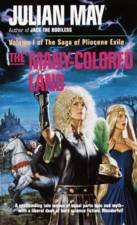
The Many-Colored Land
Science Fiction Book Club, HC omnibus, © 1981, 387 pp, ISBN #0-345-32444-7Reviewed June 2004
The Many-Colored Land is the first volume in Julian May's Pliocene Exile quartet, which is itself the first component of her Galactic Milieu nonet.
The central premise of May's universe is that sentient species have the potential to become "metapsychically operant" - developing a culture based on superhuman mental powers. By the early 21st century, humanity has started to become operant, and is adopted into the Galactic Milieu, a society of operant races. However, some humans don't fit into the Milieu's context. When a scientist discovers a one-way time portal to the Pliocene era of ancient Earth, his widow eventually begins to send these misfits there to live out their lives in a primitive idyll (or so it seems), a bargain mutually acceptable to both the misfits and the Milieu.
In the early 22nd century, a group of 8 such misfits travels through the time portal, to discover that Pliocene Earth is ruled by a semi-operant alien race called the Tanu, which is locked in endless ritual combat with their sibling race, the Firvulag. The Tanu have discovered a technology which can unlock metapsychic powers in potential operants, and have also learned that they are biologically compatible with humans. They enslave the human time-travellers for their own purposes - though a few humans rise to positions of trust and power in Tanu society - and stymie their dreams of an independent society.
The new arrivals, however, prove to be more than the Tanu bargained for: Elizabeth Orme lost her operancy when he brain was damaged, but regains her talents due to her travel through the portal. Aiken Drum and Felice Landry are both powerful - but unstable - latents. The other five are knowledgeable, skilled and dangerous humans, despite their normalcy. When Felice helps three others escape captivity, they hook up with a group of human and Firvulag rebels who have hatched a plan to begin to bring down the Tanu hegemony of ancient Earth.
The Many-Colored Land presents a well-defined, complex and engaging settings. However, despite the fact that many of the characters have depth and are interesting, it is not a character-driven novel. Told in three parts, the first is primarily an exploration of the eight travellers and the reasons they have each chosen to go into exile. The second explores the ground rules of the Tanu world they land in. And the third is the mechanics and culmination of the first stage of the rebels' plot to overthrow the Tanu masters. While this doesn't make the book any less entertaining, it's worth knowing what you're signing on for in reading it - and what you won't be getting.
Fortunately, the book's setting and situation is enough to carry a novel of its length, and the characters add some color to the narrative. The psychopathic Felice is probably the highlight, and the interplay between the aged Claude Majewski and the leader of the rebellion is also colorful and sometimes touching.
What May does best is convey the sense of frustration and powerlessness that many humans feel under Tanu rule: Some humans are outright collaborators and not to be trusted, the Tanu generally have vastly superior firepower and spying abilities. However, the Tanu have their own problems - low birth rates, interbreeding with humans, limited operancy, and political infighting among their ruling class - which makes them vulnerable to those able to take advantage of their weaknesses. This gives the reader a lot to cheer for despite some of the unsympathetic human characters.
The Many-Colored Land has many rough edges, and is very clearly the first book in a series rather than something that stands alone, but it's still well worth the read.
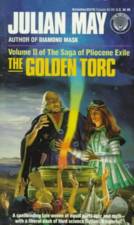
The Golden Torc
Science Fiction Book Club, HC omnibus, © 1982, 368 pp, ISBN #0-345-32419-6Reviewed June 2004
The Golden Torc begins in the middle of the events of its predecessor, The Many-Colored Land, following the travels of the second half of the group of time travellers to returned to the Pliocene epoch at the beginning of the first book. This group heads to the Tanu capital of Muriah, located in a dry land space which would one day be occupied by the Medeterranean Sea.
This group gets intimately involved in Tanu politics: The Tanu King, the Thagdal, wants to breed with human operant Elizabeth Orme to produce more powerful Tanu/human hybrids. Triggered latent Aiken Drum has developed powerful metapsychic powers and plans to challenge the Thagdal for rule of the Many-Colored Land via the Tanu's own laws. To this end he enlists the help of Stein Oleson, a physically powerful specimen who has fallen in love with another recent human arrival named Sukey, who herself has become operant. Lastly, anthropologist Bryan Grenfell finds that his beloved Mercy Lamballe - whom he travelled in time to find - is now the wife of the Tanu Battlemaster. However, the Thagdal enlists him to study the impact of humans on Tanu society.
Events play out in a complex dance: Elizabeth resists the Thagdal's plans and is recruited by Brede, the "shipspouse" whose vessel brought the Tanu and their race-brothers, the Firvulag, to Earth, and who still holds great sway over the Tanu. For that matter, Queen Nontusvel and her host of offspring regard Elizabeth as a profound threat to be eliminated. Meanwhile, the first half of the recent arrivals, flush with their victories in the north over the Tanu, plan to attack the Torc factory in Muriah, hopefully disabling the Tanu's ability to produce the devices with which they hold sway over the humans in the Pliocene.
And all of this has to come to a head in a timely manner, because a few weeks after the book begins is the Grand Combat between the Tanu and the Firvulag, a week of ritual testing and fighting between the two ancient enemy races during which the two races have a truce regarding other differences between them - a truce to which humans are not a party. This is also the venue at which Aiken Drum's challenge will come to fruition.
As with the first book, The Golden Torc is told in three parts: First, the presentation of the second half of the group of travellers to the King and Queen, and their integration into Tanu society. Second, the setting up of the machinations, the efforts of the first group of humans to attack Muriah, and Aiken Drum's proving himself to the Tanu as a worthy member of their society. And finally, the Grand Combat, at which the results of all the machinations are played out, with a sudden ending which throws everything into chaos.
The Golden Torc is also plot-driven rather the character-driven, though Aiken Drum and some of the Tanu add some color and entertainment to the overall story. Ultimately it's Felice Landry and Stein Oleson whose natures truly drive the outcome of the story, although several characters meet their fates due to their own natures. However, May rarely really brings us inside the heads of the characters (ironically, for a novel about telepaths and their ilk) and it's difficult to truly empathize with these events.
Still, this book definitely feels more sophisticated and advanced than its predecessor, and there's a lot to enjoy here as far as how May works through the implications of her set-up and the injection of the new arrivals into the milieu. At the halfway point in the quartet, I'm looking forward to reading the last two.
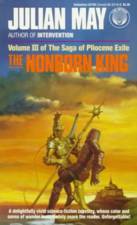
The Nonborn King
Science Fiction Book Club, HC omnibus, © 1983, 362 pp, ISBN #0-345-34749-8Reviewed August 2004
The Nonborn King - the third in May's Pliocene Exile quartet - picks up shortly after the cataclysmic events of The Golden Torc: Tanu civilization is in ruins, the Firvulag are trying to figure out how best to press their advantage, the free humans are trying to establish a society and the means to protect it, and Aiken Drum has set himself up as the titular King of the Many-Colored Land.
' There are several wild cards working against these groups' plans: First, masterclass metapsychic Elizabeth Orme has set herself up as a guiding light for the Many-Colored Land, not working directly with any of the major parties. Second, the immensely powerful and mentally unstable Felice Landry has disappeared following her initiation of the cataclysm. Finally, it turns out that a group of metapsychic rebels from the 22nd century have been living in North America in the Pliocene for the past 30 years. Mostly avoiding Tanu/Firvulag culture, the new developments intrigue their leader, masterclass Marc Remillard, while the group's children are interested in seeing whether Drum or any others would help them open a reverse-gate to the Galactic Milieu of the 22nd century, so they can join their own kind.
The book plays out with many different threads through the same period of time, a distinct change from the first two books. The central thread might be said to be Aiken Drum's effort to consolidate his power, threatened by the existence of Felice and perplexed by the existence of Marc. He has a difficult road to walk, but he also has tremendous personal cleverness and metapsychic resources at his disposal, and it's hard to bet against him, even from the outset.
The fragmented storytelling, though, makes it difficult to appreciate the book's virtues - its adept handling of the political situations the characters have to juggle. This point is also undercut by the fact that many of the original roster of 8 travellers from the first book, The Many-Colored Land, have passed away in the course of the story, and the ones remaining are either unsympathetic (Felice, Aiken) or emotionally distant (Elizabeth). So it's very hard to decide who to root for. I wished May had picked someone - Aiken, Elizabeth, Marc - and made them someone the reader could get behind, whether or not they succeeded.
The Nonborn King steps away from other possible themes and works solely with that of naked ambition and power and the struggles against it. But it's the former which is more truly in the spotlight, as so many people in the Many-Colored Land are full of ambition and/or power and willing to use the latter to pursue the former against all comers. Again, this doesn't make for an admirable cast of characters, and after a while I started wondering why one was any better than another. Felice may be raving mad, but at least she's not playing the game of kings. Her ambitions are purely self-centered, and in some ways easier to relate to.
While this volume is a lively struggle among many sides, I wonder where it's all leading to in the final volume. The fates of many of the characters have, in a sense, been sealed, as they certainly didn't survive into our time, though there are a few mysteries to work out (it seems likely, for instance, that the Tanu and Firvulag are the source of several prominent European mythologies). But the final volume will have some work to do to be ultimately rewarding, and not merely a lively adventure.
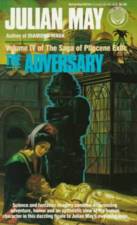
The Adversary
Knopf, HC, © 1984, 380 pp, ISBN #0-345-35244-0Reviewed August 2004
The Adversary finishes May's Pliocene Exile quartet.
Aiken Drum, human King of the Many-Colored Land of humans and Tanu aliens, finds himself beset on several sides: The Tanu's eternal brothers and foes, the Firvulag, seem ready to attack the bring about their legendary Nightfall War. He himself is not at full strength as he struggled to assimilate the minds he captured at the end of The Nonborn King. And most seriously, the children of Marc Remillard have journeyed from America to Africa and are coming to Europe to rebuild the time-gat so they can return to the Galactic Milieu of the 22nd century, and Marc and his surviving Metapsychic rebels mean to stop them whatever it takes. And events lead to culmination at Aiken's Grand Tourney between the Tanu and the Firvulag.
It's a pretty simple story, playing out the remaining threads from the first three books. It ultimately doesn't really measure up to its promise, though, for reasons presaged in The Nonborn King: The characters are generally not sympathetic, and it's hard to relate to their motivations.
Aiken is a trickster archetype, and although he takes his responsibilities as King seriously, it's hard to sympathize with him since his actions - whether by choice or because he's forced into him - always seem essentially self-serving. By this point, the remaining Tanu and Firvulag are strictly supporting characters, and they've always been "the other" from the point of view of the story anyway.
Marc's motives are often hard to fathom, as he's trying to create a "Mental Man" out of humanity, in contrast to the Unity of the Milieu. The distinction between the two is subtle and not a cause I found I could root for, although Marc himself is a suave and likeable individual. The other major character is Elizabeth Orme, a masterclass psychic and de facto caretaker of the Pliocene world, but she's not a very strong character, and she doesn't wield enough power to truly change things.
The book also features one Tony Wayland, whose story began part-way through the quartet. He's a freed human slave of the Tanu, and none too happy about being free. He keeps trying to get himself to safety, but keeps falling into the clutches of one foe or another, mostly through sheer bad luck. He's a tragicomic character, but I didn't feel like he added a lot to the story.
I think the quartet ultimately fails to deliver either of the big-ticket goods it could have. First, it could have pursued the line that the Tanu are humanity's ancestors, and that our heroes somehow manage to set the future through their actions, if a long way down the road. While our Tanu ancestry is strongly hinted at (the Tanu being akin in many ways to elves, and the Firvulag a sort of dark leprechaun), it's left at no more than that.
Second, Marc's plan to create Mental Man could have been seen through in some form or other, but I guess in the same way that showing true posthumans can't be depicted in a story written by a human, depicting true Mental Man is probably impossible. Showing us some of its ramifications from the standpoint of some normal humans would have been good, though.
In either case, the lack of sympathetic characters combined with a lack of a long-term view of the ramifications of their actions is disappointing. It ends up feeling like the proverbial sound and fury signifying nothing. Which, for 1400+ pages of text, is pretty disappointing, particularly as the number of cool ideas dwindles over time as the various threads need more space to play out. There are still 5 other books in the full Galactic Milieu sequence, but since the Pliocene Exile is, after a fashion, a coda to the story of humanity joining the Milieu, I doubt there will be much there which will illuminate this quartet any further.
I could be wrong, though.
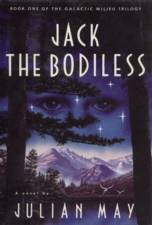
Jack the Bodiless
Knopf, HC, © 1992, 464 pp, ISBN #0-679-40950-5Reviewed July 2002
This is the first installment of May's Galactic Milieu trilogy, which actually occurs after her Pliocene Exile quartet and Intervention pair. It is, however, the first book of hers I've read. But it won't be the last.
The year is 2051, and humanity is on the verge of joining the Galactic Milieu, a community of advanced starfaring races. Mankind is on the verge of the next step in its evolution, as powerful telepaths and immortals have begun to appear. The Remillard family includes many of the most powerful telepaths, and is likely to have a leading position in humanity representation in the Milieu.
All is not well, however: Ten years earlier, during the deathbed service for Victor Remillard - a powerful and insane telepath who was defeated decades before and has lain comatose since - a creature named Fury was unleashed, and its motives are unknown. However, its creature, Hydra, is now on a murder rampage against people associated with and opposed to the Remillards. But it's all happening in the utmost secrecy, so no one really knows what's happening.
Meanwhile, Theresa Kendall Remillard, wife to Paul Remillard - leading candidate for First Magnate of the human representation to the Milieu - is pregnant. This is a problem because Theresa has been diagnosed as having an acquired genetic defect which can cripple her children, and the Milieu has forbidden her from having more children. But her eldest child, Marc - perhaps the most powerful human telepath, and only 13 years old - senses her need and spirits her and their uncle Rogatien away to a remote locale where they can wait out the winter until the child is born.
And the child, Jack, is already sentient and may be even more powerful a telepath than Marc.
Told largely as Uncle Rogi's memoirs from a century later, Jack the Bodiless is partly the beginning of an epic saga, partly a nasty little horror story, and partly an exploration of the relations of an unusual family. It's definitely only the beginning of the story - a prologue, in a way - and events are very much left hanging at the end of the novel, although many consequential events occur.
Jack the Bodiless reminds me a lot of Nancy Kress' Beggars in Spain: Both feature superhumans who are the next step in mankind's evolution, and their relationship to the world around them. May throws in the additional wrench of aliens, who are more capable than the superhumans, although humanity has the potential to outstrip them. Moreover, May adds all kinds of secret agendas on the part of Hydra, the Lylmik aliens (one of whom is manipulating Rogi). Overall it feels like a more complex novel than Beggars.
On the other hand, May isn't working with particularly concrete themes; Jack is more of a set of character studies, a mystery novel, and a political opera. Perhaps the most evident theme is that even evolved humans are still prey to many of the same flaws (and strengths) of today's humans, though perhaps this will change with enough evolution.
The big strength of Jack is that all of its plot threads are interesting, and it plays fair in its mysteries. What are the Lylmik up to? What will Jack's fate be once he's born? Who are Fury and Hydra? What do they want? What's Marc's role in all of this? How will humanity integrate into the Milieu? Some questions are answered, and others are left for later books.
Ultimately, I think the fate of the trilogy will rest on the grand elements of fitting humanity into the Milieu and pointing our future directions. If the trilogy turns out to be little more than the ongoing struggle with Fury, then I'll feel disappointed.
Still, I think I'll go back and read the earlier books in the (9-book) sequence before I continue with the trilogy. Hey, it'll only take me a year or so to get through all of them, in between all my other reading, right?
hits since 25 July 2002.